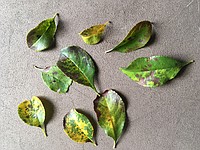Q: Shortly after pruning my flowering quince two months ago, I applied Bayer Protect & Feed Systemic because many of the older leaves were spotting and falling off. Now I'm seeing the same thing. I've pruned again to shape the plant a bit more, and so far, new leaves have looked normal. The systemic product says to apply only once a year. What is this, and do you think I should reapply the Bayer? I'm concerned.
A: Flowering quince is a deciduous shrub that begins its growing season early and often starts ending its growing season early. I would not spray anything for pests — diseases or insects — at this time. Clean up under the plant when it has totally defoliated and wait for spring. Flowering quince is a tough plant, and I would not be concerned. We just have to feel sorry for these poor plants in this heat and humidity. Water when dry, but nothing else.
■ ■ ■
Q: Does the hardy hibiscus stop putting on new blooms late in the summer as the days become shorter and they are trying to form seed pods? I've read that they are heavy feeders and have fertilized them, but I wonder if I should fertilize again this late in the season. I've continued watering them, and they are robust and healthy, but short on new flower buds.
A: The perennial hardy hibiscus with dinner-size plate blooms has a finite period of blooming. Typically, they bloom from late June through August. Some varieties can bloom longer, and some, like the Confederate rose Hibiscus mutabilis, won't start blooming until late September or October. The hardy varieties thrive with ample moisture and sunlight. Occasional fertilization is a bonus. If yours have finished blooming, I would just continue to water. They can be grown from seed, but I am too impatient to wait for them to grow. I either plant divisions in the spring or buy a new plant to get more.
Photo Gallery
In The Garden — August 28, 2021
Photographs to accompany Janet Carson's "In The Garden" column for August 28, 2021.
Q: This [reader submitted photo] grows wild and profusely in the yard, on the fence, etc. Can you identify it for me?
A: These small egg-shape fruits are from the flowers of the passionvine. I think the flowers are stunning, but the fruits are loaded with seeds. Some gardeners find the vine to be too invasive for their liking.
■ ■ ■
Q: Please tell me the name of this [reader submitted photo]. Thank you.
A: The tree in question is a tulip poplar or tulip tree (Liriodendron tulipifera). It is one of the largest native trees in our state. Its native habitat in Arkansas is Crowley's Ridge. If you plant it in your yard, stand on your chosen site and look up first. Make sure it isn't going to grow into power lines or end up too close to your house.
■ ■ ■
Q: We have these holes in all of the pecan trees in my mother-in-law's yard in Scott. As you can see, they run in a straight line. There are rows going all the way up the branches. Do you have any idea what this could be? Do the trees need to be treated?
A: Pecans are frequently visited by sapsuckers and woodpeckers, which make the regular line of holes in a tree trunk. It looks from the pictures like yours have aged fairly well. No reason to do anything on an established tree. For a young tree with frequent return visitors, some gardeners try to scare the birds off to prevent them from girdling a small trunk.
Retired after 38 years with the University of Arkansas Cooperative Extension Service, Janet Carson ranks among Arkansas' best known horticulture experts. Her blog is at arkansasonline.com/planitjanet. Write to her at P.O. Box 2221, Little Rock, AR 72203 or email jcarson@arkansasonline.com

